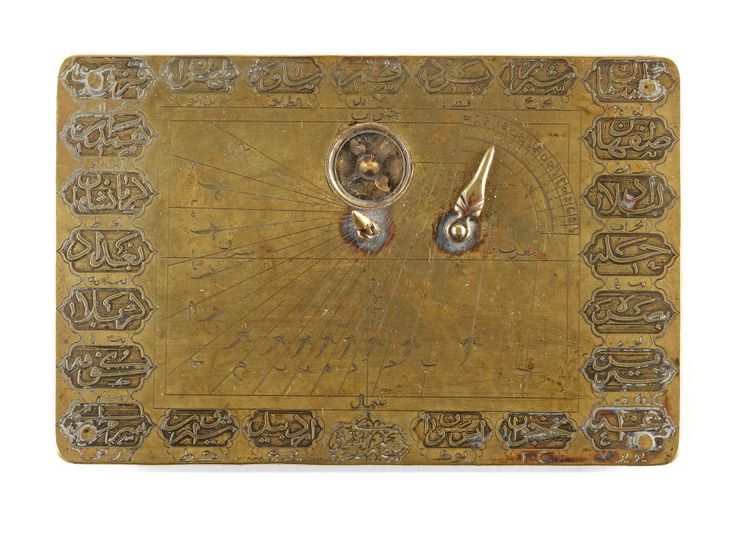A SAVAFID BRASS HORIZONTAL DIAL AND QIBLA INDICATORS, SIGNED BY MUHAMMAD MAHDI AL-YAZDI, PERSIA, SECOND HALF 17TH CENTURY
A Safavid brass horizontal dial and qibla indicator, signed by Muhammad Mahdi al-Yazdi, Persia, second half 17th century. Rectangular brass plate on four riveted feet, with inset compass box, engraved place names and cardinal directions, cartouche containing signature. 7.7 by 11.8 cm.
‘Muhammad Mahdi al-Yazdi decorated it’ There are a handful of astrolabes and compasses attributed to Muhammed Mahdi al-Yazdi, an astrolabist who worked predominantly between 1649 and 1663 (Rogers 2010, p.311, no.366). One such astrolabe signed by him and dated 1060 AH/1650 AD is currently in the Nasser D. Khalili Collection (Rogers 2010, p.311, no.366) as well as another engraved by him and dated 1667 in the Victoria and Albert Museum, London (inv.no. M.38-1916). The fine quality of this present compass highlights the care taken to preserve such tools and testifies to their importance in determining the time and direction of prayer. Moreover this indicates the popularity and interest taken in astrology and astronomy in Safavid Persia (Rogers 2010, p.311, no.366). Another recorded work by him may be in the National Maritime Museum, Greenwich, where he has signed himself as ‘Son of Muhammad Amin, Muhammad Mahdi al-khadim al-Yazdi (http://prints.rmg.co.uk/art/496540/astrolabe-reverse). Further astrolabes by Mahdi al-Yazdi are listed in the Museum of History of Sciences, Oxford (inv.nos. 1957-84/5, 1944-1/579, 1957-84/162 and 1957-84/161).
Ajbad numerals divide the surface into fourteen sections each designating an hour which is then further divided by a trefoil leaf, indicating the 30 minute sub-division. The time would be read according to the shadow cast from the tip of the hinged-gnomon placed on the meridian line of the compass (missing on the present example). The 90˚ arc in the top-right corner is divided by 1˚ markers and each five degree group is numbered with ajbad numerals. Finely engraved along the borders of the compass are the names of twenty three towns. When correctly orientated by adjusting the position of the hinged needle, the inhiraf of each place marked on the compass could be determined.




